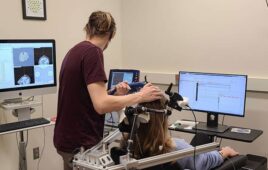
Sridevi Sarma is associate director of Johns Hopkins Institute of Computational Medicine and head of the Neuromedical Control Systems Lab [Photo courtesy of Johns Hopkins]
The models could help surgeons identify the precise location in the brain where the seizures originate (called “epileptogenic zones”) to improve treatment — and decide whether an operation is worth the risk.
“We want surgeries to go well, but we also want to prevent surgeries that may never go well,” Sridevi Sarma, associate director of Johns Hopkins Institute of Computational Medicine and head of the Neuromedical Control Systems Lab, said in a news release.
To develop the new technology, Sarma’s team created heat maps of brain activity when patients were not having seizures, as well as during stimulation with quick electrical pulses. The models reveal patterns in brain activity to identify the epileptogenic zone where a seizure begins using equations based on machine learning and calculus.
How epileptic seizures are currently diagnosed and treated
More than 65 million people worldwide have epilepsy, which can cause physical injury or even death from seizures. The condition can also cause developmental delays in children, depression, anxiety and cognitive impairment.
About 70 percent of epilepsy patients respond to anti-seizure medication.
For those who don’t, doctors try to pinpoint the precise location in the brain causing the seizures using intracranial monitoring. Surgeons place invasive electroencephalography (iEEG) leads in the brain and monitor brain activity for up to two weeks in a hospital to try to record seizures and locate the problem.
There are two treatment options for drug-resistant epilepsy: brain surgery to remove or destroy problematic tissue, or implants that deliver electrical stimulation to disrupt seizures. Surgeries are only effective about half the time due to the difficulty locating where seizures originate.
“If you find that zone and you effectively treat it, it’s a game-changer — it’s a life-changing treatment for these patients,” Sarma said.
Benefits of the new models
The researchers theorized that the epileptogenic zone that causes a seizure is constrained by healthy parts of the brain when a patient is not having a seizure. Instead of waiting for a seizure to look at brain activity in an effort to pinpoint the problem area, they developed an algorithm to predict the problem spots from brain activity when patients weren’t having seizures.
In a 65-patient study using iEEG data, the models predicted the onset of seizures and the ultimate success of a surgery with 79% accuracy, the researchers said.
“If we compare that to the traditional 50% success rate of surgeries, this could really help clinicians,” said co-author and Johns Hopkins research scientist Kristin Gunnarsdottir.
Clinicians agreed with the algorithm in 93% of seizure-free patients, the researchers said.
And instead of spending days or weeks in the hospital with monitoring electrodes placed in their head for mapping epileptic seizures, the researchers said their models identified the origin of seizures within minutes.
“We’re hoping that this can be something that we could use in patients that don’t have a ton of seizures or in the 10% of patients that don’t have seizures at all during (traditional) monitoring,” said co-author Rachel June Smith, a former post-doctoral fellow in biomedical engineering at Johns Hopkins who is now an assistant professor at the University of Alabama.
The team recently published their study in Brain and say they’re planning additional clinical trials.




